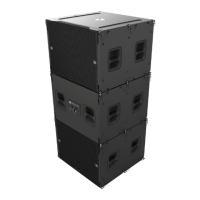25
VTX B18 | User Manual
11 - CARDIOID CONFIGURATIONS
The directivity of a subwoofer is understood to be omni-directional, meaning energy is produced equally in all directions. In reality, most
subwoofers do exhibit some front-to-back directivity (about 1 - 3dB depending on the frequency) but not enough to have any meaning-
ful impact. In some cases, the omni-directional nature of subwoofers is desirable, but in some situations a more controlled (directional)
coverage is more appropriate. The most common use case for directional subwoofers involves stage noise and specifically reducing ex-
cessive low-frequency energy from reaching the stage. Other reasons could include avoiding over-energizing a room with low-frequency
energy or, for noise pollution purposes in outdoor concerts around residential areas.
The VTX B18 individually is an omni-directional subwoofer but a cardioid coverage can be achieved by physically reversing the orienta-
tion of some of the B18 cabinets and selecting the appropriate amplifier preset.
B18
Compact Single 18” Subwoofer
IN/OUT IN/OUT
A
B
Channel Selection
SN
Vertical Horizontal
Example 1 : 3x VTX B18 in omni-directional mode (forward facing)
Example 2 : 3x VTX B18 in cardioid mode (front-rear-front)
80Hz

